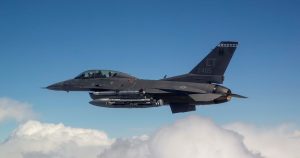
The U.S. Air Force's Golden Horde Vanguard program finished the last flight test of the Collaborative Small Diameter Bomb I (CSDB I) on May 25 at White Sands Missile Range, N.M., the Air Force Research Laboratory (AFRL) said. During the third and final May 25 flight test, as in the January and February demonstrations, the CSDBs established data link communications with one another, as two Air Force Lockheed Martin [LMT] F-16s from the 96th Test Wing at Eglin AFB, Fla.…














